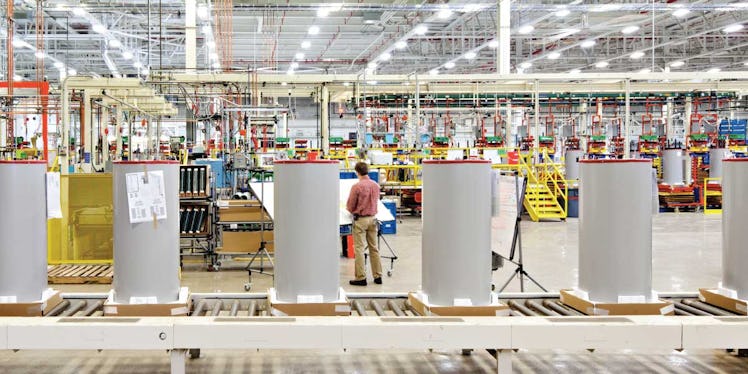How To Use Lean Manufacturing And 6 Sigma To Run Your Household
Get your kids to be lean, mean, chore-doing machines.

So you’ve finally found the right sticker/candy/technology time/outright bribery combination to get your kid to pitch in with the household chores. The only problem is they don’t know what “away” in “put that away” means. (It’s why there’s dirty underwear in the vegetable crisper.) If you want the job done right, you don’t necessarily have to do it yourself.
Elisabeth Swan is the Managing Partner & Executive Advisor at GoLeanSixSigma.com. You might know Six Sigma as that set of tools developed by a Motorola engineer to make things work the same way every time in manufacturing processes. “Lean” is that waste-reduction school of thought developed in Toyota production (aka Kaizen) that minimizes the amount and time an energy spent. Swan’s firm uses a combo of both philosophies to turn their clients into lean, mean, high functioning machines. Fortunately for you, it can also be applied to all those chores and family routines you’re wasting time on.
Have Reminders That Get In Your Way
“In the home, I’ve found what makes the biggest difference is a field called visual management,” says Swan. The first part of that involves putting your “tools” where you need them. For example, if you’re constantly rushing to pack your kid’s backpack at the last-minute, leave it by the door and toss stuff in as you remember. “The bags are right there as a visual to remind you,” explains Swan.
You Kanban Do It
Toyota used to use something called kanban cards. They cut waste in the supply chain by alerting when one department was out of stock of an item. So, if a mechanic took the last muffler, the muffler guy would see the empty box, see the sign, and refill the box. That means employees didn’t have to stand around going,“Hey, where are all the mufflers?” Your family doesn’t make car parts, but they do eat groceries. Tell your kids to leave the milk carton on the counter when you run out, instead of putting it back in the fridge. By leaving the thing you need more of in plain sight, It indicates to everybody “Hey, we’re out of milk.” This eliminates you finding out after pouring a bowl of Cap’n Crunch.
Organize Your Stuff With Pictures
Visual management works for reminders, but it also can help make sorting the endless piles of crap easier. Now that it’s getting cold, try this: Instead of digging through winter clothes at the top of the closet, use visual management to organize and label boxes with pictures of what’s inside. Hats for hat; scarves for scarves; mukluks for mukluks. “You should be able to tell how a process or routine works just by looking at a space,” says Swan.
Sort By Color, Type, Or Location
Your kids are all about visual management — especially those too young to read. Swan says instead of keeping toys hidden away in drawers or boxes, try open containers with toys sorted by color or type. It makes choosing what to play with (and then cleaning it up) a faster process. One parent Swan knows even displays their kid’s books on the floor against a wall so it’s easier for them to grab a bedtime story. “They learned what the kid’s favorites were, and put their ‘tools’ where they needed them,” she explains. “What’s easy for us is having it in a bookshelf — but that’s not easier for the kid to see and get their little fingers at them.”
One family told Swan that when it comes to packing kid lunches, they use a specific color of tupperware, and store prepared meals in a specific corner of the refrigerator. That way instead of hounding one another about whether or not they’ve finished getting the PB&Js together yet, all one parent has to do is check the fridge.
Everything In Its Right Place
Another visual management tool borrowed from the Japanese is the Poka-Yoke. It’s not a dance craze sweeping Tokyo — it’s making a task mistake-proof. Say your kid is constantly forgetting where to store their bike. Put a piece of masking tape on the garage floor to mark exactly where it should go. Now there’s no question whose fault it is when their Big Wheel gets run over by a bigger wheel.
Take A Picture Of How It’s Supposed To Be
Clean rooms; the parenting final frontier. Swan says it’s more useful to show instead of tell. On the rare occasion their room is sparkling, snap a photo for reference. Then, each week after the category 4 toddler hurricane subsides, show them them photo and say, ‘Hey, help me make the room look like this.’ “It’s an easier way to communicate,” says Swan.
Maximize Efficiency In Your Marriage
“What I mainly hear from parents is that if you got some of this stuff set up — using all the visuals, setting things up ahead of time, putting stuff where you need it — it reduces the amount of conversations based on tired irritation, and gives them more quality time with their spouses,” says Swan. “It’s basically saving their marriages.”
This article was originally published on